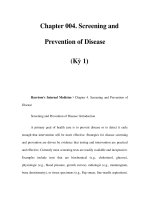Chapter 075. Evaluation and Management of Obesity (Part 1) ppt
Bạn đang xem bản rút gọn của tài liệu. Xem và tải ngay bản đầy đủ của tài liệu tại đây (90.39 KB, 12 trang )
Chapter 075. Evaluation and
Management of Obesity
(Part 1)
Harrison's Internal Medicine > Chapter 75. Evaluation and Management
of Obesity
Evaluation and Management of Obesity: Introduction
Over 66% of U.S. adults are currently categorized as overweight or obese,
and the prevalence of obesity is increasing rapidly throughout most of the
industrialized world. Based on statistics from the World Health Organization,
overweight and obesity may soon replace more traditional public health concerns
such as undernutrition and infectious diseases as the most significant contributors
to ill health. Children and adolescents are also becoming more obese, indicating
that the current trends will accelerate over time. Obesity is associated with an
increased risk of multiple health problems, including hypertension, type 2
diabetes, dyslipidemia, degenerative joint disease, and some malignancies. Thus, it
is important for physicians to routinely identify, evaluate, and treat patients for
obesity and associated comorbid conditions.
Evaluation
The U.S. Preventive Services Task Force recommends that physicians
screen all adult patients for obesity and offer intensive counseling and behavioral
interventions to promote sustained weight loss. This recommendation is consistent
with previously released guidelines from the National Heart, Lung, and Blood
Institute (NHLBI) and a number of medical societies. The five main steps in the
evaluation of obesity are described below and include (1) focused obesity-related
history, (2) physical examination to determine the degree and type of obesity, (3)
comorbid conditions, (4) fitness level, and (5) the patient's readiness to adopt
lifestyle changes.
The Obesity-Focused History
Information from the history should address the following six questions:
What factors contribute to the patient's obesity?
How is the obesity affecting the patient's health?
What is the patient's level of risk from obesity?
What are the patient's goals and expectations?
Is the patient motivated to begin a weight management program?
What kind of help does the patient need?
Although the vast majority of obesity can be attributed to behavioral
features that affect diet and physical activity patterns, the history may suggest
secondary causes that merit further evaluation. Disorders to consider include
polycystic ovarian syndrome, hypothyroidism, Cushing's syndrome, and
hypothalamic disease. Drug-induced weight gain should also to be considered.
Common causes include antidiabetes agents (insulin, sulfonylureas,
thiazolidinediones); steroid hormones; psychotropic agents; mood stabilizers
(lithium); antidepressants (tricyclics, monoamine oxidase inhibitors, paraxetine,
mirtazapine); and antiepileptic drugs (valproate, gabapentin, carbamazapine).
Other medications such as nonsteroidal anti-inflammatory drugs and calcium-
channel blockers may cause peripheral edema, but they do not increase body fat.
The patient's current diet and physical activity patterns may reveal factors
that contribute to the development of obesity in addition to identifying behaviors
to target for treatment. This type of historical information is best obtained by using
a questionnaire in combination with an interview.
BMI and Waist Circumference
Three key anthropometric measurements are important to evaluate the
degree of obesity—weight, height, and waist circumference. The body mass index
(BMI), calculated as weight (kg)/height (m)
2
, or as weight (lbs)/height (inches)
2
x
703, is used to classify weight status and risk of disease (Tables 75-1 and 75-2).
BMI is used since it provides an estimate of body fat and is related to risk of
disease. Lower BMI thresholds for overweight and obesity have been proposed for
the Asia-Pacific region since this population appears to be at-risk at lower body
weights for glucose and lipid abnormalities.
Table 75-1 Body Mass Index (BMI) Table
MI 9 0 1 2 3 4 5 6 7 8 9 0 1 2 3 4 5
eight
,
inche
s
Body Weight, pounds
8 1 6 00 05 10 15 19 24 29 34 38 43 48 53 58 62 67
9 4 9 04 09 14 19 24 28 33 38 43 48 53 58 63 68 73
0 7 02 07 12 18 23 28 33 38 43 48 53 58 63 68 74 79
1 00 06 11 16 22 27 32 37 43 48 53 58 64 69 74 80 85
2 04 09 15 20 26 31 36 42 47 53 58 64 69 75 80 86 91
3 07 13 18 24 30 35 41 46 52 58 63 69 75 80 86 91 97
4 10 16 22 28 34 40 45 51 57 63 69 74 80 86 92 97 04
5 14 20 26 32 38 44 50 56 62 68 74 80 86 92 98 04 10
6 18 24 30 36 42 48 55 61 67 73 79 86 92 98 04 10 16
7 21 27 34 40 46 53 59 66 72 78 85 91 98 04 11 17 23
8 25 31 38 44 51 58 64 71 77 84 90 97 03 10 16 23 30
9 28 35 42 49 55 62 69 76 82 89 96 03 09 16 23 30 36
0 32 39 46 53 60 67 74 81 88 95 02 09 16 22 29 36 43
1 36 43 50 57 65 72 79 86 93 00 08 15 22 29 36 43 50
2 40 47 54 62 69 77 84 91 99 06 13 21 28 35 42 50 58
3 44 51 59 66 74 82 89 97 04 12 19 27 35 42 50 57 65
4 48 55 63 71 79 86 94 02 10 18 25 33 41 49 56 64 72
5 52 60 68 76 84 92 00 08 16 24 32 40 48 56 64 72 79
6 56 64 72 80 89 97 05 13 21 30 38 46 54 63 71 79 87
MI
6 7 8 9 0 1 2 3 4 5 6 7 8 9 0 1 2 3 4
8 72 77 81 86 91 96 01 05 10 15 20 24 29 34 39 44 48 53 58
MI
6 7 8 9 0 1 2 3 4 5 6 7 8 9 0 1 2 3 4
9 78 83 88 93 98 03 08 12 17 22 27 32 37 42 47 52 57 62 67
0 84 89 94 99 04 09 15 20 25 30 35 40 45 50 55 61 66 71 76
1 90 95 01 06 11 17 22 27 32 38 43 48 54 59 64 69 75 80 85
2 96 02 07 13 18 24 29 35 40 46 51 56 62 67 73 78 84 89 95
3 03 08 14 20 25 31 37 42 48 54 59 65 70 78 82 87 93 99 04
4 09 15 21 27 32 38 44 50 56 62 67 73 79 85 91 96 02 08 14
MI
6 7 8 9 0 1 2 3 4 5 6 7 8 9 0 1 2 3 4
5 16 22 28 34 40 46 52 58 64 70 76 82 88 94 00 06 12 18 24
6 23 29 35 41 47 53 60 66 72 78 84 91 97 03 09 15 22 28 34
7 30 36 42 49 55 61 68 74 80 87 93 99 06 12 19 25 31 38 44
8 36 43 49 56 62 69 76 82 89 95 02 08 15 22 28 35 41 48 54
9 43 50 57 63 70 77 84 91 97 04 11 18 24 31 38 45 51 58 65
0 50 57 64 71 78 85 92 99 06 13 20 27 34 41 48 55 62 69 76
MI
6 7 8 9 0 1 2 3 4 5 6 7 8 9 0 1 2 3 4
1 57 65 72 79 86 93 01 08 15 22 29 38 43 51 58 65 72 79 86
2 65 72 79 87 94 02 09 16 24 31 38 46 53 61 68 75 83 90 97
3 72 80 88 95 02 10 18 25 33 40 48 55 63 71 78 86 93 01 08
4 80 87 95 03 11 19 26 34 42 50 58 65 73 81 89 96 04 12 20
5 87 95 03 11 19 27 35 43 51 59 67 75 83 91 99 07 15 23 31
6 95 04 12 20 28 36 44 53 61 69 77 85 94 02 10 18 26 35 43
Table 75-2 Classification of Weight Status and Risk of Disease
BMI
(kg/m
2
)
Obesity
Class
Risk of
Disease
Underweight <18.5
Healthy weight
18.5–24.9
Overweight 25.0–29.9 Increased
Obesity 30.0–34.9 I High
Obesity 35.0–39.9 II Very high
Extreme
Obesity
≥40 III Extremely
high
Source: Adapted from National Institutes of Health, National Heart, Lung,
and Blood Institute: Clinical Guidelines on the Identification, Evaluation, and
Treatment of Overweight and Obesity in Adults. U.S. Department of Health and
Human Services, Public Health Service, 1998.









